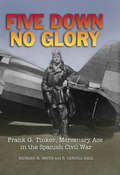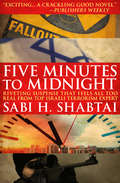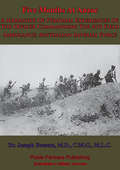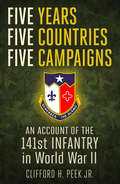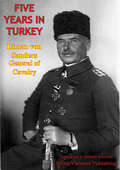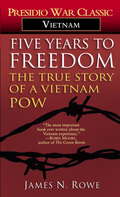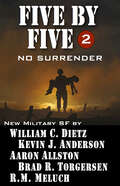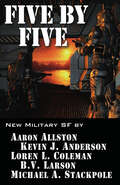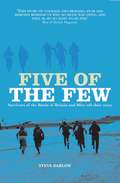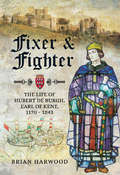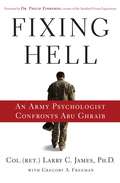- Table View
- List View
Five Down, No Glory
by R. Carghill HallFrank G. Tinker, Jr. was the top American ace flying under contract with the Spanish Republican Air Force in the Spanish Civil War. A U.S. Naval Academy graduate, Class of 1933, he went into combat with Soviet airmen during the war. Through sheer perseverance, he rose from a teenage enlisted seaman, through the U.S. Naval Academy, to the officer's wardroom-then pressed on to claim the wings of a naval aviator and to become a top-flight fighter pilot and a published author. Tinker possessed extraordinary people skills-skills that allowed him to move with relative ease among common seamen, naval officers, foreign combat pilots, left-wing literati in Madrid and Paris, and the rural folk of Arkansas, Mississippi, and Louisiana, who embraced him as "one of their own." While in Spain, Tinker socialized with Ernest Hemingway, Martha Gellhorn, Robert Hale Merriman, the leader of the American Volunteers of the Lincoln Brigade and Milton Wolff, Merriman's successor, who led the 15th International Brigade during the Battle of the Ebro. This first in-depth biography of Tinker covers his experience in combat, culminating with his commanding a Soviet squadron and terminating his contract with the government of Spain. Tinker would become the top American ace during the Spanish Civil War after downing eight enemy airplanes in combat. After returning to the United States, he wrote a memoir about fighting for Republican Spain and in June 1939 died under mysterious circumstances in Little Rock, Arkansas. The authors, well-known aviation historians, also offer a rare discussion of the aerial tactics introduced in the Spanish Civil War that became standard procedures in World War II and firmly establish Tinker's aviation feats for the historical record. Five Down, No Glory includes an introduction by Richard P. Hallion.
Five Flags: The Warship that Reshaped the World
by Stuart BuxtonFrom the American Civil War to the Meiji Restoration, one ironclad warship shaped the fate of three nations across four decades of global conflict.Five Flags tells the story of a Confederate ironclad built in secret, discovered by Union spies, sold to Denmark, returned to France, and ultimately delivered to Japan. Intended to break the Union blockade, the ship never fought for the Confederacy but instead moved through European powers before reaching Japan, where it played a role in the Meiji Restoration.Armed with a 300-pounder cannon, five inches of armor, and a twenty-foot ram, the vessel traveled from French shipyards to Spanish harbors, through Atlantic storms, and across the Pacific to become part of Japan&’s modernizing fleet.&“This is a riveting history that details the evolution of warfare… Stuart Buxton provides a wealth of information on maritime history here, told in both fact and personal stories of the crew members who served onboard. Five Flags is a fascinating chronicle of the international relationships that determined the ship&’s fate.&” —Independent Book ReviewThe book follows the ship&’s path through the civil wars of the United States, Germany, and Japan, showing how one warship connected key turning points in modern history.
Five Lieutenants: The Heartbreaking Story of Five Harvard Men Who Led America to Victory in World War I
by James Carl NelsonJames Carl Nelson tells the dramatic true story of five brilliant young soldiers from Harvard, a thrilling tale of combat and heroism.Five Lieutenants tells the story of five young Harvard men who took up the call to arms in the spring of 1917 and met differing fates in the maelstrom of battle on the Western Front in 1918. Delving deep into the motivations, horrific experiences, and ultimate fates of this Harvard-educated quintet—and by extension of the brilliant young officer class that left its collegiate and post-collegiate pursuits to enlist in the Army and lead America's rough-and-ready doughboys—Five Lieutenants presents a unique, timeless, and fascinating account of citizen soldiers at war, and of the price these extraordinary men paid while earnestly giving all they had in an effort to end "the war to end all wars."Drawing upon the subjects' intimate, eloquent, and uncensored letters and memoirs, this is a fascinating microcosm of the American experience in the First World War, and of the horrific experiences and hardships of the educated class of young men who were relied upon to lead doughboys in the trenches and, ultimately, in open battle.
Five Minutes to Midnight
by Sabi H. ShabtaiOriginally published in 1980, Five Minutes to Midnight remains of great interest as a prophetic and frightening predictive vision of the threat of nuclear terrorism.As American Independence Day approaches, many millions are planning a celebratory holiday while one radical, Carlos the Jackal, leader of the dreaded Terror International, planner of the Entebbe highjacking and the massacre at the Munich Olympics, has plans to raise the level of terror to new heights while bringing the threat home to the U.S. with a stolen nuclear weapon.Standing in his way is Sam Sartain, a member of an elite counterintelligence team, who has long pursued Carlos and has learned to analyze the twisted mind and plans of a mass killer. As he follows a series of deadly leads that range from the University campus in Berkeley, California to a prison in Berlin, he must race against time to prevent a colossal act of destructive madness in Washington, DC itself.
Five Months At Anzac - [Illustrated Edition]: A Narrative Of Personal Experiences Of The Officer Commanding The 4th Field Ambulance, Australian Imperial Force
by Dr M. D. C. M. G. M. L. C Joseph Lieve BeestonIllustrated With the Gallipoli Campaign Pack - 71 photos and 33 mapsThe Gallipoli Peninsular in 1915 was an awful place to be an Allied soldier, for the Australians who had travelled thousands of miles to answer the call of their mother country it must have seemed like hell. Overlooked by intrenched Turkish and German soldiers, the narrow strip of land that they lived on was hard won with blood, the air whistled with shot and shell day in and day out. For Dr Joseph Beeston, a native of Newcastle New South Wales, his duty was the wounded of the Anzac forces which he tended with great care and skill. As he records in his memoirs of Gallipoli the fighting was tough and the conditions even worse, but despite all this he and his comrades kept their wry sense of humour. He was always cheered by his fellow Anzac soldiers and dedicated his book of anecdotes to them; stating that "One never ceased admiring our men, and their cheeriness under these circumstances and their droll remarks caused us many a laugh."A lively and engaging memoir from an Anzac veteran.
Five Ways to Surrender (Mission: Six #5)
by Elle JamesHis life is dedicated to the SEALs.His heart is dedicated to her.Their mission was clear: do not engage! But when his SEAL team is ambushed, “Big Jake” Schuler sacrifices his safety to draw the terrorists away from his unit. When village missionary teacher Alexandria Parker runs right into Jake’s arms, they must hide together in the wild hills of Niger, causing Jake to discover that Alex is as tough as she is beautiful. This mission he’ll engage with feelings he thought he buried a lifetime ago.Mission: Six
Five Years Five Countries Five Campaigns: An Account of the One-Hundred-Forty-First Infantry in World War II
by Clifford H. Peek Jr.Five Years, Five Countries, Five Campaigns, first published in 1945, is the account of the activities of the U.S. Army’s 141st Infantry Regiment (36th Division) during World War II. Based in San Antonio Texas, and part of the Texas National Guard, on November 20, 1940, the men changed from civilians to citizen-soldiers by presidential order. Additional recruits were added, followed by intensive training, and, by April 1943, the Regiment was in North Africa, then Italy, France, Germany, and Austria. Some notable firsts for the 141st Infantry included: among the first American troops to land on the continent of Europe in World War II; among the first troops to enter Rome; the first Infantry Regiment to land on the coast of southern France; the first Regiment in the Seventh Army to cross the Moselle River; and the first 36th Division troops to enter Germany. Their combat record was also impressive: from September 9, 1943, until the end of the war, the Regiment experienced 361 days of combat (137 days in Italy, 204 days in France, 17 days in Germany, 4 days in Austria). During this period, the Regiment sustained more than 6,000 casualties, including 1,126 killed, approximately 5,000 wounded, and over 500 missing in action. Five Years, Five Countries, Five Campaigns provides an in-depth look at this Regiment, with descriptions of the Regiment’s fighting at Salerno, River Rapido, Monte Cassino, in the Alsace region, and more. Included are 15 pages of maps.
Five Years In Turkey [Illustrated Edition]
by Lieutenant-General Otto Liman Von Sanders Carl ReichmannNumerous maps, portraits and plans."War memoirs of Liman von Sanders, the German General who brilliantly commanded the Turkish defence at Gallipoli in 1915, before being defeated by Allenby in Palestine. Written while a post-war P.O.W. of the British in Malta.Otto Liman von Sanders (1855 - 1929) will always be associated with the Dardanelles campaign in which he commanded the Turkish Fifth Army, the army that defended Gallipoli, defeated the allied invasion and, after a campaign lasting some eight months (April-December 1915) forced the Allies to give up and withdraw. He was a cavalry officer who was commanding the German 22nd Division in Cassel when, in June 1913, he was offered the post of Chief of a German Military Mission in Turkey: he accepted and took up his post in December of that year and took over command of the Turkish First Army Corps, in Constantinople. Three months later, March 1914, he was given command of the Turkish Fifth Army defending Gallipoli and as such his version of events is of considerable interest to the history of that campaign. He later (1918) commanded the combined Turkish/German Yilderim force in Palestine where he was defeated by the greatly superior forces of Allenby. This account is based on notes written up in Malta where he was detained for some six months in 1919 before being permitted to return to Germany."-N&M Print Version
Five Years of My Life: An Innocent Man in Guantanamo
by Murat KurnazIn October 2001, nineteen-year-old Murat Kurnaz traveled to Pakistan to visit a madrassa. During a security check a few weeks after his arrival, he was arrested without explanation and for a bounty of $3,000, the Pakistani police sold him to U.S. forces. He was first taken to Kandahar, Afghanistan, where he was severely mistreated, and then two months later he was flown to Guantanamo as Prisoner #61. For more than 1,600 days, he was tortured and lived through hell. He was kept in a cage and endured daily interrogations, solitary confinement, and sleep deprivation. Finally, in August 2006, Kurnaz was released, with acknowledgment of his innocence. Told with lucidity, accuracy, and wisdom, Kurnaz's story is both sobering and poignant--an important testimony about our turbulent times when innocent people get caught in the crossfire of the war on terrorism.
Five Years to Freedom
by James N. RoweWhen Green Beret Lieutenant James N. Rowe was captured in 1963 in Vietnam, his life became more than a matter of staying alive.In a Vietcong POW camp, Rowe endured beri-beri, dysentery, and tropical fungus diseases. He suffered grueling psychological and physical torment. He experienced the loneliness and frustration of watching his friends die. And he struggled every day to maintain faith in himself as a soldier and in his country as it appeared to be turning against him.His survival is testimony to the disciplined human spirit.His story is gripping.From the Paperback edition.
Five Years to Freedom: The True Story of a Vietnam POW
by James N. RoweWhen Green Beret Lieutenant James N. Rowe was captured in 1963 in Vietnam, his life became more than a matter of staying alive.In a Vietcong POW camp, Rowe endured beri-beri, dysentery, and tropical fungus diseases. He suffered grueling psychological and physical torment. He experienced the loneliness and frustration of watching his friends die. And he struggled every day to maintain faith in himself as a soldier and in his country as it appeared to be turning against him.His survival is testimony to the disciplined human spirit.His story is gripping.From the Paperback edition.
Five by Five: No Surrender
by Kevin J. Anderson Aaron Allston William C. Dietz Brad R. Torgersen R M MeluchFive by Five: No Surrender is the second collection in the series of short novels by five masters of military science fiction. In these pulse-pounding tales, the best (or worst) soldiers in the galaxy are pitted against powerful aliens on distant battlefields. In William C. Dietz&’s Legion of the Damned® story, Legio Patria Nostra, the insectoid Ramanthians have occupied Earth, and the Confederacy of Sentient Beings turn to the xenophobic Hudathans for help. But Hudathan relics have been stolen by ex-legionnaire thieves—and the Hudathans won't join the Confederacy unless Legion Captain Deacon Smith can get them back. Set in the world of Harlan Ellison&’s classic Outer Limits episode &“Soldier,&” Kevin J. Anderson&’s Prisoner of War follows a set of warriors in a never-ending future war, men bred for nothing but the battleground, and how they cope with the horrors of peace. When expensive, classified shipments of military hardware go missing, Conflux Armed Forces policewoman Kalliope Reardon follows the trail far outside the boundaries of the civilized galaxy, and into the heart of occupied enemy territory in Brad R. Torgersen&’s Reardon&’s Law. When A. C. Cade was exposed as a fraud, Cade&’s son makes himself into the elite father pilot he believed his father was, defending Earth against a desperate alien invader which has no use for humankind and absolutely nothing to lose in Dagger Team Seven by R. M. Meluch. In Coffee Black Sea, the saga of the Dollgangers from Aaron Allston&’s Big Plush (Five by Five Vol. 1) continues. Bow, BeeBee, Lina, and new &’gangers escalate the risks of their quest for survival . . . by turning their eyes to the stars.
Five by Five: No Surrender
by Aaron Allston Loren Coleman Michael A Stackpole Kevin J Anderson B. V. LarsonFace aliens, monsters, and more in these five short novels by five masters of military science fiction. It&’s a war out there . . . In these pulse-pounding tales, the best (or worst) soldiers in the galaxy are pitted against powerful aliens on distant battlefields. Never before published stories about monsters, deadly combat tech, treachery, and honor: Big Plush by Aaron Allston (a novella from the Action Figures series)—The Dollgangers, artificial people made in mankind&’s image, take up arms in a desperate bid to win their freedom. Comrades in Arms by Kevin J. Anderson—A damaged cyborg soldier and an enemy alien fighter turn their backs on the war and try to escape. But the human and alien governments can&’t tolerate the two deserters working together, so they join forces to hunt them down. Shores of the Infinite by Loren L. Coleman (a novella from the ICAS File series)—Separated from command & control, Combat Assault Suit troopers force a beachhead to liberate a new planet from the cyborg threat. The Black Ship by B.V. Larson (a mech novella from the Imperium Series)—A human settlement on the deadliest planet ever colonized clings to life . . . but today new invaders are coming down from the stars. Out There by Michael A. Stackpole—The Qian have discovered humanity and welcomed them into their star-spanning empire. The benefits they offer humanity are many, and they don&’t want much in return: just the best human pilots available to take apart a most diabolical enemy.
Five by Five: Target Zone
by Kevin J. Anderson Michael A. Stackpole Sarah A. Hoyt Dani Kollin Eytan Kollin Doug DandridgeAn anthology of five military sci-fi novellas capture the action and adventure of futuristic wars—on and off the battlefield. TARGETS ARE LOCKED! Michael A. Stackpole—The Star Tigers are commandeered by a powerful alien overseer on a covert mission to a world long abandoned by an ancient species. There, the ruins of a forgotten war will tip the balance of their war, unless the Star Tigers can prevent it. Sarah A. Hoyt—Lucius Dante Maximilian Keeva is a well-respected leader of the Usaian Revolution, but treason in the ranks can cost him everything that makes life worth living—unless he takes justice into his own hands and breaks every military regulation in its pursuit. Doug Dandridge—Faced with an enemy more than two hundred times her own size, Cinda Klerk has two options: hide, and let it destroy the planet she is supposed to protect, or find a way to even the odds and kill the enemy, even at the cost of her ship and crew. Eytan Kollin and Dani Kollin—As the Unincorporated War envelops the entire solar system, a father must come to the rescue of a daughter he never raised. But he'll have to convince her to save herself first. Kevin J. Anderson—In the war against an alien menace, Earth&’s greatest military commanders risk themselves on the front lines, but with an escape hatch: If the situation goes terribly wrong, they can switch places with a safe soldier far from the battlefield. But the cannon-fodder volunteers don&’t consider that such a good deal.
Five for Freedom: The African American Soldiers in John Brown's Army
by Eugene L. MeyerOn October 16, 1859, John Brown and his band of eighteen raiders descended on Harpers Ferry. In an ill-fated attempt to incite a slave insurrection, they seized the federal arsenal, took hostages, and retreated to a fire engine house where they barricaded themselves until a contingent of US Marines battered their way in on October 18. The raiders were routed, and several were captured. Soon after, they were tried, convicted, and hanged. Among Brown's fighters were five African American men—John Copeland, Shields Green, Dangerfield Newby, Lewis Leary, and Osborne Perry Anderson—whose lives and deaths have long been overshadowed by their martyred leader and who, even today, are little remembered. Only Anderson survived, later publishing the lone insider account of the event that, most historians agree, was a catalyst to the catastrophic American Civil War that followed.Five for Freedom is the story of these five brave men, the circumstances in which they were born and raised, how they came together at this fateful time and place, and the legacies they left behind. It is an American story that continues to resonate in the present.
Five of the Few: Survivors of the Battle of Britain and Blitz Tell Their Story
by Steve DarlowA personal wartime human history of five RAF airmen who fought Fighter Command&’s air battles during World War II. Five distinguished RAF airmen, four pilots and one radar operator/navigator, who fought air battles during the Battle of Britain and the Blitz, have recounted their experiences in detail to author Steve Darlow. Their stories have never before been published, and they talk engagingly of their service life, combats, losses, injuries, friendships and fears—flying Spitfires, Hurricanes, Blenheims, Beaufighters and Havocs. One pilot tells of the time he fell victim to the enemy, knowing he was going down with his plane. A Beaufighter radar operator remembers being involved in shooting down a German aircraft—&“He took a vertical dive, struck the ground and exploded with a shower of incendiaries. I felt like a child with a new toy. I had at last proved myself but for some reason I suddenly felt a little sad.&” These men would also distinguish themselves in subsequent air campaigns—night defense of the UK, offensive operations over the continent and support to D-Day and beyond. In between the aerial combats and ground attack operations, promotions, decorations and command responsibilities would come their way. But not all would make it through safely to the end of the war. One would end up behind barbed wire. Collectively Five of the Few is a war story of youth maturing, through aspiration and idealism, courage and bravado, fear and heroism, memory and reflection. It is a reminder of why so much was owed, and still is, by so many to so few.
Five of the Many: Survivors of the Bomber Command Offensive from the Battle of Britain to Victory Tell their Story
by Steve DarlowThe daring exploits of five RAF airmen who carried out the truly devastating offensive to defeat the unquestionable evil of Nazi Germany in World War II. In Five of the Many, the enthralling stories of Wellington pilot Rupert Cooling, Wellington and Mosquito pilot Jack Goodman, Halifax pilot Joe Petrie-Andrews, Lancaster pilot Tony Iveson and Halifax and Mosquito navigator Harry Hughes transport the reader into the intensity of the bomber battle over western Europe. Collectively these men help thwart German invasion plans in 1940, and counter the U-boats on the seas and in the factories. They hinder German military industrial production, taking part in some of the most devastating raids in history. They counter the development and deployment of German V-weapons and fly deep into hostile airspace to attack the heart of Germany, Berlin. They clear the way for the Normandy landings and blast the German reinforcement of the battle area. They indulge in special ops, including sinking the Tirpitz, and they directly support the land advances to Germany and disrupt enemy supply lines during the German Ardennes offensive. Their stories are a fitting tribute to the youthfulness of the many, the skill of the many, the determination of the many and the sheer guts of the many. Bomber Command's motto required its airmen to "Strike Hard, Strike Sure." These five special men did just that, fighting hard, flying sure, along the flight path to victory in Europe.
Fix Bayonets!
by John NorrisThe bayonet is an essential item of a soldier's kit even on today's modern hi-tech battlefield. This work examines the origins of this humble weapon and the 'cult of the bayonet' as espoused by the Russian General Alexander Suvorov who asserted that The bullet misses, the bayonet does not. The first bayonets appeared in France in the early 17th century and soon they were being used by every army in Europe. The author examines the spread of this simple weapon and how it led to fundamental changes being made in battlefield tactics. Over 300 years later, in the age of hi-tech warfare and weapons of mass destruction, the bayonet is still in service with armies around the world. British and US forces in Afghanistan regularly have their bayonets fixed. Fix Bayonets illustrates how tactics changed and the design of the weapon, although fundamentally the same, has evolved over the centuries.Much myth and legend surrounds the subject of bayonet charges and the weapon has become an icon of defiance and the determination to do whatever it takes to win. The author examines evidence for the reality of such actions. How did the ordinary soldier feel to be told 'fix bayonets'? John Norris draws on personal accounts of soldiers using bayonets in combat from the Napoleonic and Crimean Wars, various Colonial campaigns, through the World Wars, Falklands War and into the 21st century in Afghanistan. In so doing he explains the seemingly anachronistic survival of this simple weapon on the modern battlefield.
Fix Bayonets! (Classics Of Naval Literature Ser.)
by Captain John W. Thomason Jr.A collection of picturesque and observant stories about the hard-fighting Fifth Marine Regiment in France by a writer who has been called the Kipling of the Marines Corps.During his 27 years as a Marine officer, John W. Thomason also became one of America s foremost illustrators and by virtue of his singular combination of talents, Thomason immortalized the Marines who served in World War I.These stories follow their grim daily lives with ironic humor, acute observation and sympathy from Belleau Wood to the march to the Rhine.— Print Ed.
Fixer & Fighter: The life of Hubert de Burgh, Earl of Kent, 1170 – 1243
by Brian HarwoodHubert de Burgh rose from obscure beginnings to become one of the most powerful men in England. He loyally served first King John and then the young Henry III and played a crucial role in saving the Plantagenet dynasty when it was at its most vulnerable. During King Johns disastrous wars in France, Hubert held Chinon castle against the besieging French for a whole year. He remained loyal when the Barons rebelled against John and, when they invited French invaders to intervene, Hubert successfully held Dover Castle for the king against a siege led by the French Prince Louis. After Johns death, he held it for the new king, 9-year old Henry, against a renewed siege. In August 2017 he struck the final blow against the French invasion, which still held London, when he defeated a powerful fleet carrying French reinforcements at the naval Battle of Sandwich. Hubert continued to serve Henry III, making important reforms as Justiciar of England and leading military campaigns against the Welsh Prince Lewellyn. He eventually lost favour due to the machinations of his rivals and narrowly avoided execution but was eventually reconciled with his king and able to die a peaceful death. Incredibly, this is the first full-length biography of this remarkable man.
Fixing Hell: An Army Psychologist Confronts Abu Ghraib
by Gregory A. Freeman Larry C. JamesThis is the story of Abu Ghraib that you haven't heard, told by the soldier sent by the Army to restore order and ensure that the abuses that took place there never happen again.In April 2004, the world was shocked by the brutal pictures of beatings, dog attacks, sex acts, and the torture of prisoners held at Abu Ghraib in Iraq. As the story broke, and the world began to learn about the extent of the horrors that occurred there, the U.S. Army dispatched Colonel Larry James to Abu Ghraib with an overwhelming assignment: to dissect this catastrophe, fix it, and prevent it from being repeated. A veteran of deployments to Guantanamo Bay, Cuba, and a nationally well-known and respected Army psychologist, Colonel James's expertise made him the one individual capable of taking on this enormous task. Through Colonel James's own experience on the ground, readers will see the tightrope military personnel must walk while fighting in the still new battlefield of the war on terror, the challenge of serving as both a doctor/healer and combatant soldier, and what can-and must-be done to ensure that interrogations are safe, moral, and effective.
Fixing Intelligence: For a More Secure America
by William E. OdomBasing his text in large part on a study he authored in 1997, published by the National Institute of Public Policy, Odom (a senior fellow at the Hudson Institute and a former director of the National Security Agency) considers recommendations for the reform of American intelligence activities and organization. Among his suggestions are granting more intelligence oversight authority over all the diverse intelligence organizations to the Director of Central Intelligence; eliminating CIA obstructionism in expanding military intelligence capabilities; recognizing the need to have national managers for the separate disciplines of signals, imagery, and human intelligence; and taking counterintelligence activities out from under the provenance of the law enforcement agencies. Annotation ©2004 Book News, Inc. , Portland, OR (booknews. com)
Fixing the Facts: National Security and the Politics of Intelligence
by Joshua RovnerWhat is the role of intelligence agencies in strategy and policy? How do policymakers use (or misuse) intelligence estimates? When do intelligence-policy relations work best? How do intelligence-policy failures influence threat assessment, military strategy, and foreign policy? These questions are at the heart of recent national security controversies, including the 9/11 attacks and the war in Iraq. In both cases the relationship between intelligence and policy broke down-with disastrous consequences. In Fixing the Facts, Joshua Rovner explores the complex interaction between intelligence and policy and shines a spotlight on the problem of politicization. Major episodes in the history of American foreign policy have been closely tied to the manipulation of intelligence estimates. Rovner describes how the Johnson administration dealt with the intelligence community during the Vietnam War; how President Nixon and President Ford politicized estimates on the Soviet Union; and how pressure from the George W. Bush administration contributed to flawed intelligence on Iraq. He also compares the U.S. case with the British experience between 1998 and 2003, and demonstrates that high-profile government inquiries in both countries were fundamentally wrong about what happened before the war.
Flags of Our Fathers: A Young People's Edition (Playaway Adult Nonfiction Ser.)
by James Bradley Ron PowersIn this unforgettable chronicle of perhaps the most famous moment in American military history, James Bradley has captured the glory, the triumph, the heartbreak, and the legacy of the six men who raised the flag at Iwo Jima. Here is the true story behind the immortal photograph that has come to symbolize the courage and indomitable will of America. In February 1945, American Marines plunged into the surf at Iwo Jima—and into history. Through a hail of machine-gun and mortar fire that left the beaches strewn with comrades, they battled to the island's highest peak. And after climbing through a landscape of hell itself, they raised a flag. Now the son of one of the flagraisers has written a powerful account of six very different young men who came together in a moment that will live forever. To his family, John Bradley never spoke of the photograph or the war. But after his death at age seventy, his family discovered closed boxes of letters and photos. InFlags of Our Fathers, James Bradley draws on those documents to retrace the lives of his father and the men of Easy Company. Following these men's paths to Iwo Jima, James Bradley has written a classic story of the heroic battle for the Pacific's most crucial island—an island riddled with Japanese tunnels and 22,000 fanatic defenders who would fight to the last man. But perhaps the most interesting part of the story is what happened after the victory. The men in the photo—three were killed during the battle—were proclaimed heroes and flown home, to become reluctant symbols. For two of them, the adulation was shattering. Only James Bradley's father truly survived, displaying no copy of the famous photograph in his home, telling his son only: "The real heroes of Iwo Jima were the guys who didn't come back. " Few books ever have captured the complexity and furor of war and its aftermath as well asFlags of Our Fathers. A penetrating, epic look at a generation at war, this is history told with keen insight, enormous honesty, and the passion of a son paying homage to his father. It is the story of the difference between truth and myth, the meaning of being a hero, and the essence of the human experience of war.
Flags of Our Fathers: Heroes of Iwo Jima
by James Bradley Ron Powers Michael FrenchNow abridged for young people, Flags of Our Fathers is the unforgettable chronicle of perhaps the most famous moment in American military history: the raising of the U. S. flag at Iwo Jima. Here is the true story behind the immortal photograph that has come to symbolize the courage and indomitable will of America. In February 1945, American Marines plunged into the surf at Iwo Jima-and into history. The son of one of the flag raisers has written a powerful account of six very different men who came together in the heroic battle for the Pacific's most crucial island.From the Hardcover edition.
